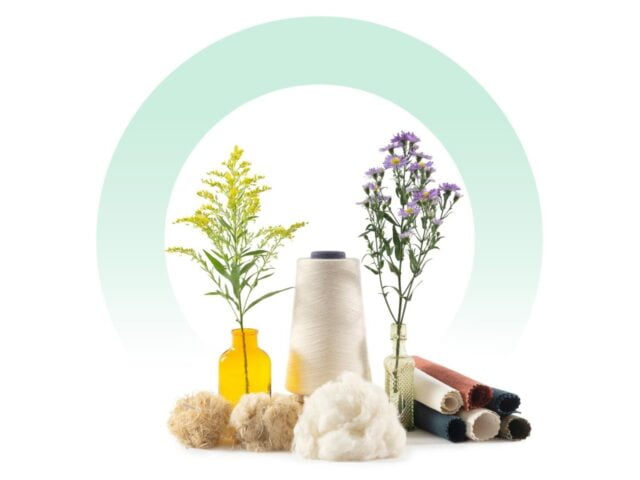By completely changing the basic fabric or the accessories that we use, people can potentially stop generating waste that leads to landfills. And at the same time make a unique fashion statement. It’s a win-win situation here.
Transitioning from polyester to cotton or even organic cotton is not advisable. Reports from the World Wildlife Fund (WWF), states that cotton plants need around 10,000 liters of water to produce just one kilo of usable cotton. This makes it the most water-guzzling crop.

Replacing cotton with other alternatives like plant waste or agro residue is one way to go about things.
How Are These Alternatives Made?
Once the edible part is harvested, from plants like, banana, pineapple, hemp, jute, lotus, bamboo, eucalyptus, flax, cork, sugarcane, etc, what is left is plant biomass or waste residue. This is useless and is generally burnt which leads to air pollution or landfills.
This waste contains biopolymers like cellulose, lignin, pectin, etc. So, rather than burning this residue, it is converted into textile fibers.
Natural Fibres
C Sekar, from Tamil Nadu, is known for his clothes that are made from natural fibers. “Every day, in the temples of Tamil Nadu, Andhra Pradesh, and Kerala, enormous amounts of banana plants are used to decorate the temple and the deity.
The next day, they are thrown out. We collect and source fibers from this waste. Banana stems are the best source of fiber to make the yarn,” says this third-generation weaver from Anakaputhur.
Ananafit is the brand under which Sekar markets all his products. He has done several experiments with natural fibers. He has a group of women weavers who love to use fabric from plants like banana, pineapple, bamboo, and aloe vera to make yarn.
Sekar is currently experimenting on how to produce silk yarn from lotus plants. He actually holds a Limca Book of Records (2011), for weaving a saree pallu using 25 natural fibers.
Also Read: Crazy Things Women Did To Stay Fashionable During The Great Depression And World War II
Hemp & Vegan Leather
“Fabric from hemp is good too. The more you wash a garment made from hemp the more soft and comfortable it becomes,” says Neha Rao, a young designer from Mumbai. She is also the head of the Hemp Fabric Lab of Bombay Hemp Company (BOHECO).
The major problem she faces is that hemp cannot be legally cultivated in India and she has to import the yarn from other South Asian countries, majorly from China where 70% of the world’s hemp is cultivated. Indian users are yet to be made aware of the comfort that hemp gives to its wearer.
Arundhati Kumar is another young designer who loves to make accessories from vegan leather. She is from Kolkata but has her brand set up in Mumbai under the name ‘Beej’. She works with a wide range of innovative materials.
A few of these include cork extracted from cork plant, Piñatex made from Pineapple leaf fibers, and Desserto, a leather alternative made from cactus pulp. She makes a variety of belts, bags, and clutches.
Priyal Turakhia designed a women’s garment with plastic waste. Through her brand Nirantar, she hopes to make plastic waste reusable in the fashion industry. She does not even use any dyeing material, which is another pollutant.
“These bottles and their caps are so colorful that they make the designed apparel quite colorful. So by cutting into different shapes, smoothing and shaping the plastic waste, I could easily use them to enhance my designs, and they are as comfortable as any other attire which is embellished with sequins,” said Priyal on her women’s garment.
Global fashion industry
Global fashion brands like Salvatore Ferragamo have made dresses from orange peel. Brands like H&M, Hugo Boss, Paul Smith use Pinatex (made from pineapple leaves), Gucci, and Prada to open up to plant-based fabrics.
Young designers are coming up with new trends and ideas to improve the fashion industry and the environment. Handloom weavers too are ready to incorporate new steps. Now it’s up to the government and big textiles industries to step in and help in making the world as pollutant-free as possible, in a fun and fashionable way.
Image Sources: Google Images
Sources: The Better India, Newsly.live, Flipboard, +More
Find The Blogger: @Natashaly05
This post is tagged under: banana saris, bamboo jeans, lotus shawls, desi, fashion, going green, fabric, accessories, unique fashion, World Wildlife Fund, cotton, polyester, alternatives, water-guzzling crop, waste residue, biopolymers, C Sekar, Tamil Nadu, natural fibers, Ananafit, Limca Book of Records, Neha Rao, Hemp, Vegan Leather, Arundhati Kumar, designer, China, young, Beej, Salvatore Ferragamo, H&M, Hugo Boss, Paul Smith, Priyal Turakhia, Gucci, brands, Prada, Handloom, weavers, textiles, industries, pollutant-free, environment
Other Recommendations:
Watch: Why You Should Never Try A Beauty Blogger’s Makeup At Home
Such a simple topic yet so perfect keep it up and heads on your shoulder ….proud of you
Awesome work!!
Very informative!!